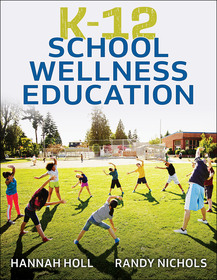
K–12 School Wellness Education
-
10% KEDVEZMÉNY?
- A kedvezmény csak az 'Értesítés a kedvenc témákról' hírlevelünk címzettjeinek rendeléseire érvényes.
- Kiadói listaár GBP 65.00
-
31 053 Ft (29 575 Ft + 5% áfa)
Az ár azért becsült, mert a rendelés pillanatában nem lehet pontosan tudni, hogy a beérkezéskor milyen lesz a forint árfolyama az adott termék eredeti devizájához képest. Ha a forint romlana, kissé többet, ha javulna, kissé kevesebbet kell majd fizetnie.
- Kedvezmény(ek) 10% (cc. 3 105 Ft off)
- Kedvezményes ár 27 948 Ft (26 618 Ft + 5% áfa)
Iratkozzon fel most és részesüljön kedvezőbb árainkból!
Feliratkozom
31 053 Ft

Beszerezhetőség
Becsült beszerzési idő: A Prosperónál jelenleg nincsen raktáron, de a kiadónál igen. Beszerzés kb. 3-5 hét..
A Prosperónál jelenleg nincsen raktáron.
Why don't you give exact delivery time?
A beszerzés időigényét az eddigi tapasztalatokra alapozva adjuk meg. Azért becsült, mert a terméket külföldről hozzuk be, így a kiadó kiszolgálásának pillanatnyi gyorsaságától is függ. A megadottnál gyorsabb és lassabb szállítás is elképzelhető, de mindent megteszünk, hogy Ön a lehető leghamarabb jusson hozzá a termékhez.
A termék adatai:
- Kiadó MG – Human Kinetics
- Megjelenés dátuma 2025. szeptember 30.
- Kötetek száma Trade Paperback
- ISBN 9781718218406
- Kötéstípus Puhakötés
- Terjedelem240 oldal
- Méret 278x216x18 mm
- Súly 698 g
- Nyelv angol 700
Kategóriák
Rövid leírás:
Educators learn to integrate physical activity with wellness by blending nutrition, emotional health, fitness, and injury prevention via an innovative model. Aligned with national standards and featuring practical tools and success stories, it transforms schools into hubs of holistic well-being.
TöbbHosszú leírás:
Health education and physical education teachers are the champions of wellness in schools, but often health and physical activity are taught separately in the K-12 environment. The School Wellness Education (SWE) model is a unique approach that teaches students why physical activity benefits their well-being to holistically influence students toward healthy lifestyles. K-12 School Wellness Education prepares future physical education teachers with strategies to use a whole school approach to promote health, wellness, and fitness.
Authors Hannah Holl and Randy Nichols, the educators who developed the SWE model, have based K-12 School Wellness Education on the Whole School, Whole Community, Whole Child (WSCC) model and aligned the content with SHAPE America’s most recent National Physical Education Standards.
The text incorporates traditional areas of games, sports, and fitness performance and, more importantly, focuses on why physical activity matters. Units are not based on games or fitness activities but are instead focused on the National Physical Education Standards and the five components of Living Well: nutrition, social and emotional wellness, the human body and responses to physical activity, health-related fitness, and injury prevention and safety.
The Living Well focus helps elementary, middle school, and high school students progress along their physical literacy journey and health literacy journey. It demonstrates for students how a physically active lifestyle is associated with wellness, disease prevention, and an overall improved quality of life.
K-12 School Wellness Education offers physical education teacher education (PETE) students and in-service teachers the following:
- Information on how SWE (and its related evidence-based research) differs from other models
- Curriculum development tools such as templates for unit plans, unit storyboards, and lesson plans
- K-12 grade-level benchmarks to measure student progress on their physical and health literacy journeys
- Over 30 success stories and leadership examples to guide strategies for collaboration, garner administrative support, and create a culture of wellness in schools
- Special features such as learning objectives, key term lists, sidebars, and chapter wrap-up sections to support reader comprehension




